|
"The true scientist
is one who is committed to knowing, to scientia, which is the attempt to
understand the ultimate nature of reality, without bias, prejudice, or
commitment to an ideology or belief system. Otherwise, he is unworthy of
the name."--------1974,
Astronaut, Edgar D. Mitchell (6th man on the moon), "Psychic Exploration, A Challenge For
Science," p. 32.
"----(as
observed by Spencer & Gillen) the (aboriginal)
women (in Australia)
cut into their scalps with their digging sticks (during
self-mutilation rituals for the deceased person)
until blood poured down their faces, while their male relatives gashed
themselves deeply across their thighs with stone knives until they could
not stand. Now the natives say that this "Donnybrook Fair" placates the
ghost of the dead man, but it is obvious that the angriest ghost in
Australia could not harm them as much as they harm themselves---"---------,
1948,
William Howells, "The Heathens, Primitive Man And His Religions"
republished in 1962 by the American Museum Of Natural History,
p. 163.
"---on the second day of
the (Dani tribe)
funeral ceremony (in New Guinea).
After the hand (of a young girl)
has been numbed by a blow on the elbow, the fingers are chopped off with
a blow from a stone adze. Like pigs and shell goods, the fingers are
gifts considered necessary to placate the ghosts. Although nearly every
Dani girl loses several fingers, as a woman she does a wide range of
work--"--------1968,
Robert Gardner & Karl G. Heider, "Gardens Of War, Life And Death In
The New Guinea Stone Age," pp. 100 & 101.
"It is in
blood sacrifices, especially where human beings are offered instead of
animals, that "part-of-the-whole" sacrifices, like the offerings of
human fingers, hair, or blood drawn through self-inflicted wounds are
sometimes used as replacements."--------1999,
O. W. Hampton, "Culture Of Stone, Sacred And Profane Uses Of Stone Among
The Dani," p. 21.
"In one
anthropological account after another I had read of the custom of
sacrificing a finger joint when a relative died. No imagining can equal
a picture of a woman with only stumps on her hands working or caring for
a child. The word "sacrifice" suddenly assumes new meaning."--------1968,
Margaret Mead, comments in "Foreword" in, Robert Gardner & Karl G. Heider, "Gardens Of War, Life And Death In
The New Guinea Stone Age," pp. 100 & 101.
"---the dominant attitude in
most simple cultures is fear, and distaste for any contact (with
a ghost), the more so as the poor
ghost has little to do except watch the living and wish he were one of
them again."1948,
William Howells, "The Heathens, Primitive Man And His Religions"
republished in 1962 by the American Museum Of Natural History,
pp. 157.
"No phenomenon
(in tribal New
Guinea), either real or imagined, is of
greater significance to Dani life than their belief in
ghosts. The logic of their existence tests on their premise that all
happenings are the result of both human and ghostly instrumentality."---------1968,
Robert Gardner & Karl G. Heider, "Gardens Of War, Life And Death In
The New Guinea Stone Age," p. 87.
"During the
period of mourning which follows immediately upon the death of a man and
occupies a period of from twelve to eighteen months, no person must
mention the name of the deceased except it be absolutely necessary to do
so, and then only in a whisper for fear of disturbing and annoying the
man's spirit which in ghost form, or as they call it, Ulthana, walks
about"--------1899,
Baldwin Spencer & F. J. Gillen, "Native Tribes Of Central Australia," p.
498.

GHOSTS AND FLINTKNAPPING
CULTURAL RITUAL AND MODERN ART
Ghosts and flintknapping seem unrelated. But they
actually do connect in different ways, from whimsical to terrifying.
Whimsical as modern flint-knapped art and terrifying for stone tools
used in self-mutilation rituals. When considering every aspect of ghosts
and flintknapping, there are interesting perspectives worth mentioning.
Ghosts do have a long history. Some archaeologists believe that
religious ideas may date sometime prior to 300,000 years ago, within the Lower Paleolithic period. Stone tools date to at
least 2.5 million years ago. |
|
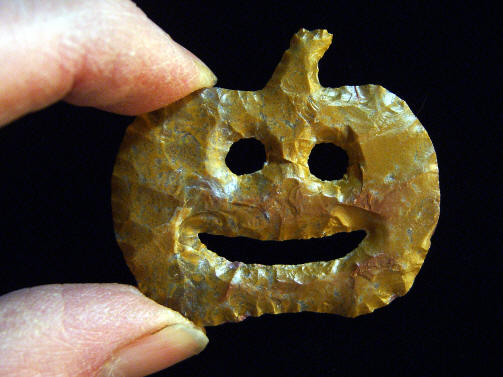
CLICK ON PICTURE FOR LARGER IMAGE
PUMPKIN BY DAN THEUS
"JASPER" THE PUMPKIN
This nice looking little pumpkin was
made this year by Dan Theus. His name is "Jasper" and he happens to
be made of Jasper. The mouth was started from a natural cavity and
delicately enlarged by
pressure flaking. The eyes were started with a dremel tool by grinding
from both sides until a small hole was made. Then shaping the circles by
pressure flaking. The working time for this pumpkin was two hours. "Jasper" the pumpkin measures 2 inches (5.1 cm) from
left to right. |
|
|
Wouldn't it be interesting to know when the
idea of a ghost first appeared in a human mind.
The oldest known, undisputed, human burial dates to 100,000 years ago at Skhul
Cave in Israel. This ritual burial contained bones that were stained
with red ochre which suggests a concern for ghosts, spirits and possibly a soul. Most
people, in today's industrialized societies, relate to ghosts more as
entertainment. TV, Halloween and religion have removed all the old fears
that once promoted complex rituals that specifically guided and
controlled ghosts. This does not mean that ghosts are not real, just
that most of the once powerful cultural traditions that dealt with them
are no longer important. On-the-other-hand, some areas of the world
still have a great fear and respect for ghosts. Many of their ancient
traditions are still observed. |
|
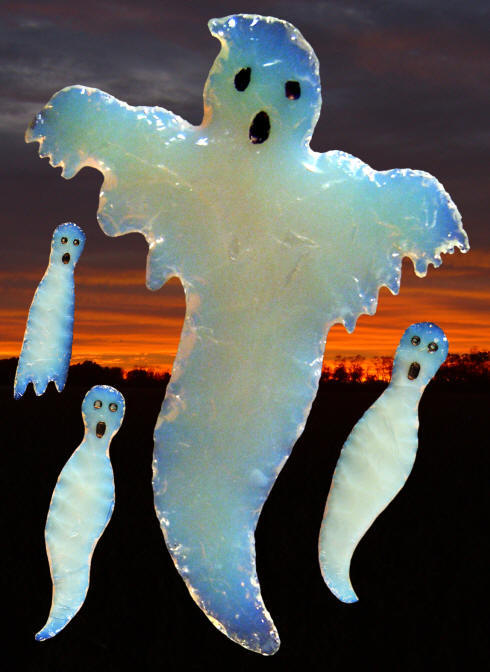
"SPOOKY" GHOSTS
BY DAN THEUS
GLASS
These four phantoms
are wonderful examples of Dan Theus' Halloween "ghost art." The material
is a uniquely colored white opalescent glass made in China. It's the
perfect material for making ghosts. The largest ghost has a wind blown
cap and "tail" and out stretched arms with hands. The eyes were carved with a
dremel tool and colored with black ink. The flintknapping time was about
forty-five minutes. The three smaller ghosts are actually larger in size
than they appear in this computer altered picture. They average about 4
inches (10.1 cm) long. The largest ghost measures 4 9/16 inches (11.6
cm) long and 3 1/4 inches (8.3 cm) wide. |
|
|
On a lighter side, Dan Theus'
Halloween ghosts are wonderful examples of flint knapped art. The five ghosts illustrated in
this article were made from a uniquely colored white opalescent glass
made in China. It's perfect material for knapping ghosts. The wind blown
cap and "tail" and out stretched arms with hands, on the two
largest examples, are wonderful design features. The eyes were carved
with a dremel tool and colored with black ink. The flintknapping time
for these
ghosts was about forty-five minutes each. One ghost measures 4 9/16 inches
(11.6 cm) long and 3 1/4 inches (8.3 cm) wide. The other ghost measures
4 3/8 inches (11.1 cm) long and 3 5/16 inches (8.4 cm) wide. |
|
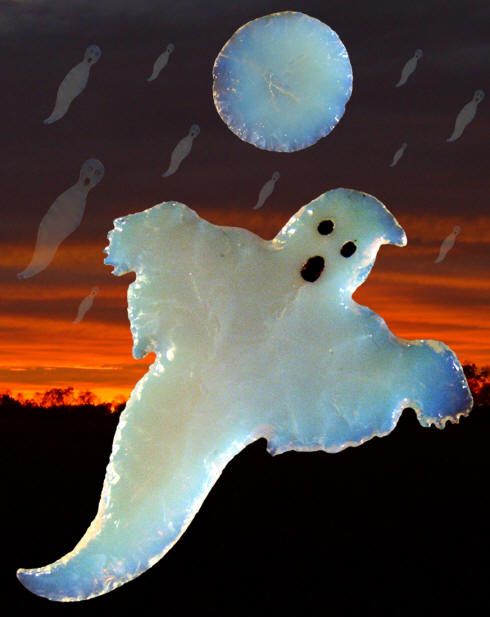
GHOST RISING TO A HARVEST MOON
BY DAN THEUS
GLASS
Two more great
examples of Dan Theus' "ghost art. This picture
shows a ghost rising up to a harvest moon. The ghost has out stretched
arms, curved "tail," and wind blown cap.
The eyes were carved with a dremel tool and colored with black ink. The
flintknapping time was about forty-five minutes. This ghost is made of
white opalescent glass from China and measures
4 3/8 inches (11.1 cm) long and 3 5/16 inches (8.4 cm) wide. |
|
|
Another example of Dan Theus' art work is a pumpkin
named "Jasper" that happens to be made from a piece of Jasper. The mouth
was started from a natural cavity and delicately enlarged by
pressure flaking. The eyes were started with a dremel tool by grinding
from both sides until a small hole was made. Then shaping the circles by
pressure flaking. The working time for this pumpkin was two hours. "Jasper" the pumpkin measures 2 inches (5.1 cm) from
left to right. |
|
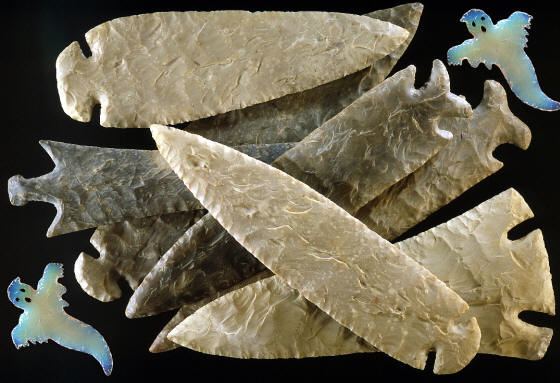
CLICK ON PICTURE FOR LARGER IMAGE
"GRAY GHOSTS"
BY BRYAN REINHARDT
EDWARDS CHERT
These points have
been called "gray ghosts, by collectors of stone artifacts in the US for
many years. They were named for and made from gray Edwards chert from
Texas. These modern-made
"spears" have caused quite a lot of confusion for more than half a
century. The buying public has had a "devil" of a time identifying them
as either old or new. In fact, they have become a sort of modern legend.
The first ones were produced in Bryan Reinhardt's "flint
spear" factory sometime in the 1940's. "Gray ghosts" are
large modern-made "flint spears" that were made during the 40's, 50's, 60's and early
70's. "Gray ghosts" are scary only when the people that
purchase or inherit them, believe they have ancient artifacts of
great value. But they're actually nice examples of one man's
modern flintknapping art. Each one is a little different and unique. True
"gray ghosts" are credited to Bryan Reinhardt because he made so many more
than anyone else. He passed away in about 1982, by some reports, of
silicosis of the lungs. He sold them by the case of 144 and must have
made a great many thousands of them. |
|
|
Another way to look at ghosts and flintknapping are
the points known as gray ghosts and ghost points. The most famous
examples are "Gray Ghosts." They were named for and made from gray
Edwards chert from Texas. These are modern-made "spears" that have
caused quite a lot of confusion for more than half a century. The buying
public has had a "devil" of a time identifying them
as either old or new. In fact, they have become a sort of modern legend.
The first ones were produced in Bryan Reinhardt's "flint
spear" factory sometime in the 1940's. "Gray ghosts" are
large modern-made "flint spears" that were made during the 40's, 50's, 60's and early
70's. "Gray ghosts" are scary only when the people that
purchase or inherit them, believe they have ancient artifacts of
great value. But they're actually nice examples of one man's
modern flintknapping art. Each one is a little different and unique. True
"gray ghosts" are credited to Bryan Reinhardt because he made so many more
than anyone else. He passed away in about 1982, by some reports, of
silicosis of the lungs. He sold them by the case of 144 and must have
made a great many thousands of them. |
|
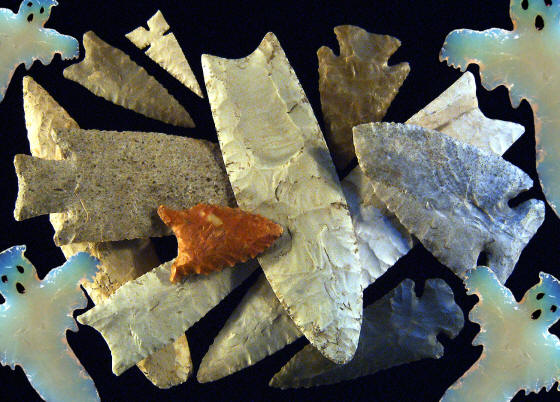
CLICK ON PICTURE FOR LARGER IMAGE
"GHOST POINTS"
MODERN-MADE
None of the points in this
picture are old. They were made by modern flintknappers and there's no
problem if they were collected as art. They become "ghost points"
when they're purchased with no evidential information that might
support the value placed on them. In-other-words the buyer thinks
they're old. They are usually higher priced items
that only have a good story. Since the beginning of the great
flintknapping boom in the United States, in the 1970's, there are more
"ghost points" in circulation that old ones. They number in the
millions. Some even have authentic patina, for example, if they've been
place in running water for a few months. |
|
|
Another ghost that might
concern "collectors" are what some have called "ghost points." These are
the points that people buy with no evidential information that might
support the value placed on them. In-other-words, they can be high priced items that only have a good story. Since
the beginning of the great flintknapping boom in the United States, in
the 1970's, there are more "ghost points" in circulation than old ones.
They number in the millions. Some even have authentic patina, for
example, if they've been place in running water for a few months. |
|
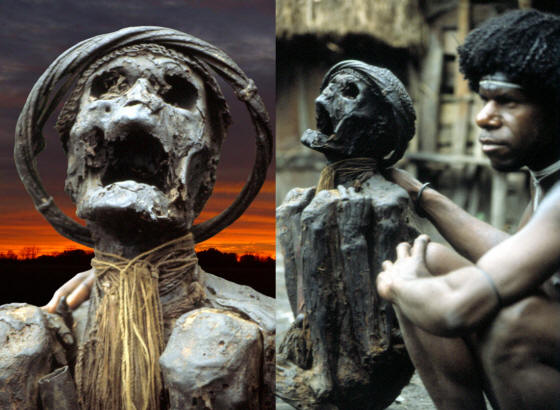
IMAGE FROM LITHIC CASTING LAB'S COLLECTION OF
ORIGINAL IMAGES
CLICK ON PICTURE FOR LARGER IMAGE
MUMMY OF A DANI WARRIOR
WAMENA, WEST PAPUA,
INDONESIA
ISLAND OF NEW GUINEA
Burial practices
vary in New Guinea, just as they do everywhere else in the world. Some
cultures believe the soul is directly affected by the way the body is
processed, which may be the reason why this Dani warrior was mummified,
supposedly
200 or more years ago. It's one of the
attractions that people might see when they travel to the Baliem Valley
in the highlands of western New Guinea. This area is the home of the
Dani people who number about 100,000. The Grand Valley, as the region is
also called, was only discovered 75 years ago, in 1938. The tribe is one
of the world's more recent stone tool making cultures. The area is only
reachable by plane and, as a result, is slow to modernize, due to its
remoteness. |
|
|
The darker side of ghosts
and flintknapping are the stone tools that were used in ritual
ceremonies for the purpose of appeasing the ghost of the recently
deceased. These funerals can be lengthy and involve self-mutilation. The
most extraordinary example may be finger amputation when a close family member dies. Dani women and young girls,
of western New Guinea, would traditionally have one joint of
one finger removed with a stone adze. One report describes the
amputation as being performed by a man who was a specialist in the
procedure. The selected finger was tied between the second and third
joint. Then the elbow was struck with a hard stick to help deaden the
nerves in part of the hand. The operator extends the finger on a board. Then removes it up
to the second joint with a small transverse (straight
edged) stone adze. The wound is then
dressed with a mixture of clay and ashes. The severed finger is burned
in the dying ashes of the funeral fire. The procedure is now prohibited
but many Dani women still display their missing fingers to curious
tourists. |
|
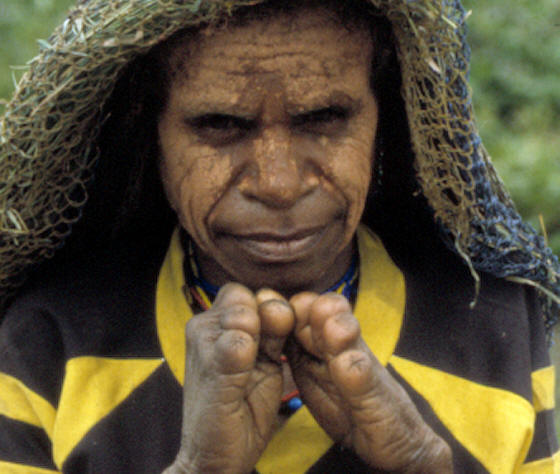
IMAGE FROM LITHIC CASTING LAB'S COLLECTION OF
ORIGINAL IMAGES
CLICK ON PICTURE FOR LARGER IMAGE
DANI WOMAN SHOWING
RITUALLY AMPUTATED FINGERS
WEST PAPUA, INDONESIA
ISLAND OF NEW GUINEA
One of the most extraordinary burial/mutilation rituals in the world
dates to the recent past in western New Guinea. The practice
involved the amputation of a finger when a close family member died.
One report describes the amputation as being performed by a man who
was a specialist in the procedure. The selected finger was tied
between the second and third joint. Then the elbow was struck with a
hard stick to help deaden the nerves in part of the hand. The operator extends the finger on a board. Then removes it up
to the second joint with a small transverse (straight
edged) stone adze. The wound is then
dressed with a mixture of clay and ashes. The severed finger is burned
in the dying ashes of the funeral fire. The procedure is now prohibited
but many Dani women still display their missing fingers to curious
tourists, like the woman in this picture.
Finger mutilation or amputation is also known in some African
tribes for such reasons as curing sickness and even to advertise a
sign of engagement or marriage. The phenomena is also attributed to
some Pacific islands where fingers are removed when a close relative
dies. |
|
|
Another extreme example of placating a ghost comes from
Central Australia in the late 1800's. Ethnographers Gillen and Spencer
describe what they saw as an "orgy of self-mutilation." The event was
the funeral of a Warramunga man. The women cut their scalps with their
digging sticks until blood flowed down their faces and the men cut their
thighs with stone knives until they could not stand. Twenty-three wounds
were counted on one man. After they rested for a few hours, the women
began hitting each other in the head with war clubs. The next day, some
women were still cutting their scalps while others began cauterizing
their wounds with burning sticks. Gillen and Spencer comment in their
report that "it's obvious that the angriest ghost in Australia could not
harm them as much as they harm themselves." They also comment that
another reason why they may be so violent to themselves is for a
psychological way out of despair. |
|
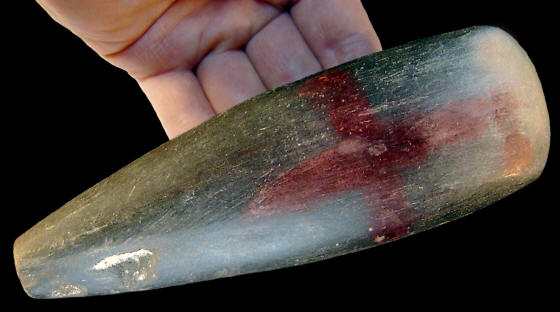
ADZE / AXE BLADE
DANI CULTURE
WEST PAPUA, INDONESIA
ISLAND OF NEW GUINEA
This painted blade was collected in September of 1995 from a Loni
compound in the village of Ibele. It was given to a brother and
sister who were
in the village buying bow sets and other items. A tribesman, who was not
selling it, asked them
to take it away from the village at the request of the local missionary.
A display-exchange stone that was used in a recent funeral was also given to them.
They had met the child who had died in a fire in the previous year. It's
reported that this stone may have been used in a finger cutting
ritual. The fact that it's painted suggests that it wasn't used as a
normal wood cutting tool. It measures
6 1/2 inches (16.5 cm) long, 2 1/8 inches (5.3 cm) wide and 1 5/16
inches (3.3 cm) thick.
People in western New Guinea made their axes and adzes from
quarried rock that was reduced to manageable size with large
hammerstones. They were then percussion flaked into shape with smaller
hammerstones then ground smooth. The grinding process sometimes removed
all the percussion flake scars. According to Hampton (1999), unhafted
axes and adzes are sometimes impossible to differentiate. He comments
that, "When I cannot be definitive in typing loose blades as either adze
or axe blades, I have chosen to call the blades adze/axe blades." |
|
|
Science does not
believe in ghosts. It's an illusion of the mind they say. So what are
ghosts anyway. Like "Bigfoot" they never go away. Someone is always
talking about them, seeing them or hearing them. Many old and
traditional cultures know them as malevolent frightful things. They are
said to cause everything from death and illness to general mayhem. But,
on-the-other-hand, modern witnesses of ghosts often describe more
pleasant experiences of loved ones appearing to reassure them that they are
ok. So the subject remains complex and each person is left to make his
own reality. |
|
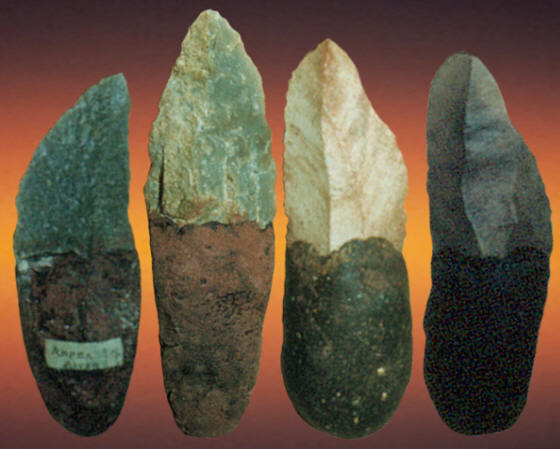
PICTURE OF KNIVES FROM LITHIC CASTING LAB'S COLLECTION OF
ORIGINAL IMAGES
RESIN HAFTED LEILIRA
KNIVES
CENTRAL & NORTHERN AUSTRALIA
Leilira knives were used for both utilitarian and ritual
purposes. As objects of utility, they were used for general purposes,
but also as weapons for hand to
hand fighting and for
butchering animals. As ritual objects, knives of this type could also
have been used in self mutilation mourning rituals. |
|
|
Belief in ghosts must be one of the most common and long
lasting cross cultural metaphysical ideas of humans. Names for them
probably reach to the moon by now. Reported sightings are almost always
ephemeral (short lived).
This writer can offer a ghost story that he saw while traveling a lonely
road in 1966 at three in the morning. The only car that past, going the
other way with a slow motion effect, was driven by a friend. It was odd,
he shouldn't have been there. The next day it was discovered that he
died that night in a car accident. Is it a trick of sight or an
undigested bit of beef or crumb of cheese, as Scrooge would say? Well
just remember, when you look at the phenomenon long enough the
phenomenon will often times look back at you. So be careful out there. |
|
"REFERENCES"
1899, Spencer Baldwin & Gillen, F.
J., "Native Tribes Of Central Australia."
1948, Howells, William, "The Heathens, Primitive Man And His
Religions" republished in 1962 by the American Museum Of Natural
History.
1968, Gardner, Robert & Heider, Karl G., "Gardens Of War, Life And
Death In The New Guinea Stone Age."
1974, Mitchell, Edgar D., "Psychic Exploration, A Challenge For
Science."
1994, Mauze, Marie, "The Concept Of The Person And Reincarnation Among The
Kwakiutl Indians," Amerindian Rebirth: Reincarnation Belief
Among North American Indians And Inuit, published by the University
of Toronto Press.
1999, Hampton, O. W., "Culture Of Stone, Sacred And Profane Uses
Of Stone Among The Dani."
2010, Varner, Gary R., "Ghosts, Spirits & The Afterlife In Native
American Folklore And Religion."
|
|
RECENT
LISTINGS HOME
ORDERING |